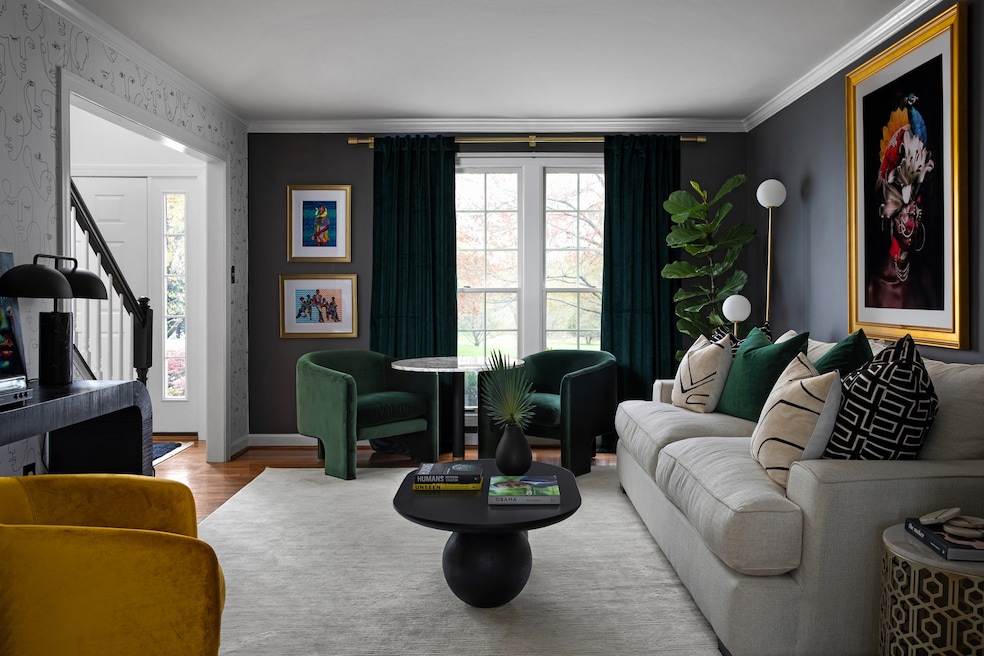Jenna Morrow faced an exacting client when tasked with redesigning the living room in this single-family home: herself.
When Morrow, the founder of interior design firm Morrow Design Studios, purchased the Colonial in the Washington, D.C., suburbs, the room was drowning in taupe and packed with traditional furniture.
“I was like, ‘Oh, no, no, no, no,’” she said with a laugh, recalling her knee-jerk reaction. “This needs color. This needs comfort.”
Morrow craved something “small, quaint, and very intimate,” emotions that an expanse of blah didn't evoke.
“I wanted to walk in there and be able to feel inspired, relaxed, but also as if the possibilities are endless,” she detailed.
The revamped 13-by-16-foot space meets the brief, Morrow said. Even after completing the design about three years ago, she hasn’t “changed a thing in it.”
Here’s why the space works:
The furniture is oriented to support different interactions
When it came to laying out her space and arranging the furniture, Morrow aimed to marry social space and workspace — beauty and utility.
“Normally, when you see a living room, you see a sofa, maybe a sectional, and an accent chair or two,” she explained. “But in this space, we switched it up and wanted to make it multifunctional rather than solely conversational. So, you're seeing a sofa with one accent chair and a bistro table that accommodates up to four seats. We only added two. This allows a space to not only be a room where you can lounge and relax, but you can also have the conversational aspect with others or you can sit and enjoy some isolation, whether it's working at the table, having coffee or a small meal at the table.”
In that sense, Morrow explained, the layout pulls inspiration from a library: “You can work, you can rest, you can converse.”
The space surprises visitors with wallpaper
When clients think of accent walls, Morrow explained, they’re often considering paint. But, hoping to amplify the room’s creative aura, she selected wallpaper covered in continuous line drawings.
“The reason this works is because when you have wallpaper that has a particular pattern, especially one that's larger in scale, if you flank all of the walls in that large-scale pattern, the room can be overwhelming,” Morrow detailed. “That wasn't what we wanted in this space. We wanted a room that was relaxing, comforting and welcoming. So, we decided to go with one wall that had the large-scale pattern, but also the pattern is black and white, so it pairs well with any type of any color, furniture, [or] fabric.”
Morrow placed the paper carefully, covering a wall that’s visible only from inside the room.
“When you go into that room, you're solely seeing the gray walls from the main entrance. And then when you turn, you're like, ‘Oh my gosh, this is so unique and different.’ And so again, it's one that's not overwhelming to the space, but it's also very intriguing. It adds dimension to that portion of the room.”
The patterned wallpaper served one more purpose, Morrow noted. “It did a really good job of taking the place of having to add a lot of wall art or wall décor to an otherwise really large wall.”

The moody walls that aren’t too dark
But what about the other three walls in the room?
Morrow wanted a shade of black, but nothing too intense. Two popular Sherwin-Williams options — Tricorn Black and Iron Ore — were “entirely too dark,” Morrow found, but the gray-tinged Peppercorn offered just enough complexity and warmth.
“I didn’t want that space to feel sad or like your standard gray,” she said. “We picked that color because it added depth to the space. Like you look in there and you’re like: ‘Oh my gosh, this deep-colored room. I want to see how the rest of it looks.”
Morrow also liked how the rich hue played off the room’s white couch — the only piece in the space that came from the designer’s previous home. “I think the paint color draws you in, and then the rest of the room — the colors, the textures, the silhouettes, all of that — makes you want to continue engaging with the space.”
It acknowledges that books can be art, too
When many of Morrow’s clients confront a blank wall, they see a space that needs filling with wall art or photos, but not everyone has a budget for that.
“A lot of people don’t think about decorating with things they collect or things that they enjoyed,” she noted. For Morrow, that collection was books, which she placed on a narrow strip of wall. Rather than traditional shelving, however, she mounted invisible floating shelves, playing “with the sleekness of the room.”
“You’re also not overpowering that wall and stuffing as many books [on the shelves] as you can,” she said. Instead, Morrow treated the shelving as “art,” offering “a very different and unique way to contribute décor to a space by using items that aren’t actually decor.”

The lighting serves a purpose
You might notice that this living room has no central lighting fixture: no overhead pendant, no recessed bulbs. That was intentional, Morrow explained, because the room gets ample natural light throughout the day. But in the evening, Morrow wanted to lean into the room’s moody comfort.
“So, I’ve got accent lighting,” she said. A floor lamp capped with warm globes and an accent lamp on a side table shed a glow across the room once the sun goes down, and a reading lamp mounted along the couch provides extra task lighting.
“It was very intentional that every light cast a mood,” Morrow said. “Rather than having these bright lights at the top and the ceiling, [these lights signal] this is a place of comfort. This is a place to rest, to get some work done and to just really relax.”
